Camino de Santiago - French Way - Stage 18 - Lédigos to Sahagún
Total distance: 16.1 km
Head out of Lédigos the same way you came in and take a left fork along a track through some fields. After approximately 300 metres take a right and after 500 metres take a left. Continue down the road for about 1.5 kilometres until you come to the village of Terradillos de los Templarios.
Terradillos de los Templarios gets part of its name from the fact that it once belonged to the Order of the Knights Templar who built a pilgrim hostal in the 12th century called San Juan unfortunately, only the occasional stone remains to mark its existence.
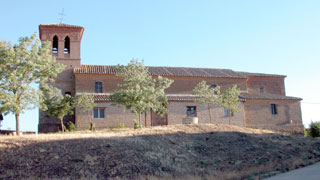
The 18th century Iglesia de San Pedro is unusual in that it is made from brick. This is because when it was built there was a lack of local stone. Inside there is an interesting 13th century crucifix.
There are 2 albergues in Terradillos de los Templarios. The first, Los Templarios, you will have passed on the main road as you entered the village. The other is called Albergue Jacques de Molay, named in remembrance of the last Grand Master of the Knights Templar who was burnt at the stake in front of Notre Dame Cathedral in Paris by King Philip IV of France.
Leaving the village take a track on your left towards a minor road then go right through some fields. The path runs parallel to the main road and crosses the stream known hereabouts as the Arroyo de Templarios. After about 3 kilometres you reach the small village of Moratinos with its underground bodegas. There is a fountain next to the Iglesia Parroquial Santo Tomás de Aquino and a rest area here but little else.
Walk down the main street through Moratinos past the church until after approximately 2.5 kilometres you come to the village of San Nicolás del Real Camino.
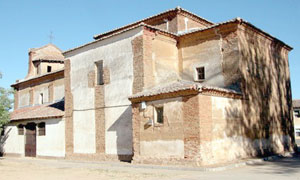
San Nicolás del Real Camino, like Terradillos de los Templarios, is a village associated with the Knights Templar. Here you will find another brick built church, the Iglesia de San Nicolas de Bari with its ornate Baroque altar.
The Albergue Laganares is the only accommodation here but it does offer a Pilgrim menu and for those wanting to catch up on emails, it has internet access.
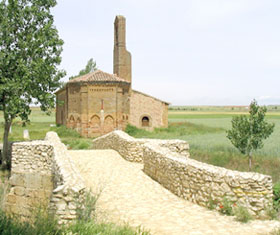
Not long after you have left the village you come across a sign that says 'Senda de Peregrinos', a pilgrim path that runs parallel to the main road. An alternative path runs through some fields following the river. Whichever route you take after about 1.5 kilometres you will be leaving the province of Palencia and entering the province of Leon. Both routes also meet at the 12th century Ermita de La Virgen del Puente located next to a Roman bridge over the Rio Valderaduey.
The Ermita de la Virgen del Puente had originally been a pilgrim hospice and the path we will be following into Sahagún is known as the Camino Frances de la Virgen (the French Camino of the Virgin). About a kilometre along the path there will be an underpass under the main road, go through it and in the distance you will see a large white grain silo, aim for this. Once you have reached the grain silo take a left passing the railway station and the bull ring and take a bridge over the railway tracks into Sahagún.
Sahagún derives its name from the saint San Facundo who was martyred here and the 9th century monastery, Abadia de San Benito el Real de Sahagún, built in his honour by King Alfonso III de Asturias, el Magno. The monastery grew in importance during the reign of Alfonso VI de Castilla who showered the town with prestige and money for the help he received from the monastery during the war with his brother Sancho III. During the Middle Ages the monastery became the most powerful Benedictine monastery in Spain controlling at least 100 other monasteries from Tierra de Campos to Liébana in the heart of the Picos de Europa and down to Segovia, near Madrid.
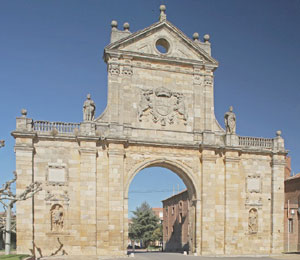
The Benedictine monastery was disbanded in the 19th century and most of the buildings were destroyed during two major fires that destroyed much of the town of Sahagún. Only the 17th century Arco de San Benito, the 12th century Capilla de San Mancio and the 19th century Torre del Reloj remain of this once powerful monastery.
A number of the Castilian royal family were buried in the monastery including Alfonso VI of Castilla and his 5 wives. After the fire that destroyed the monastery in 1810 their remains were moved and eventually re-interred in 1835 in the 16th century Monasterio de las Madres Benedictinas de Santa Cruz.
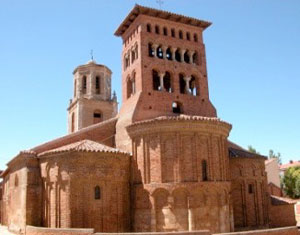
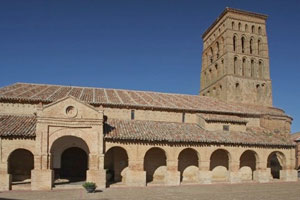
Two churches worth seeing are the 13th century Iglesia de San Lorenzo and the 12th century Iglesia de San Tirso (left picture). Both have been built in the Mudéjar style. They are very similar in look but the Iglesia de San Lorenzo is built entirely out of brick, and the Iglesia de San Tirso is part built in stone with the upper parts constructed out of brick.
Accommodation on the stage
You can find accommodation in either one of 3 albergues along with at least 4 hostals. There is also a campsite, Pedro Ponce, on the way out of town. Several restaurants in the town offer a pilgrim menu and there are all the necessary amenities you would expect with a town of this size.

